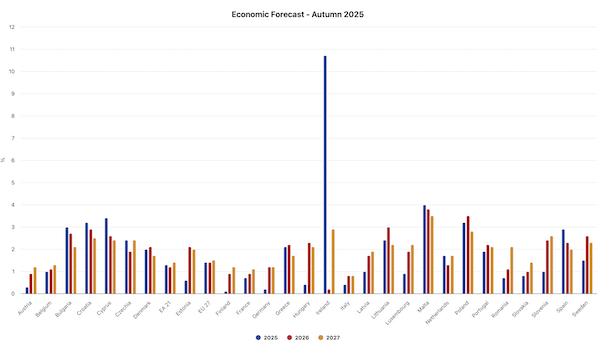 EU GDP growth forecast for 2025–2027;
Credit: European Commission
EU GDP growth forecast for 2025–2027;
Credit: European Commission
On Monday 17 November 2025, the European Commission published its “Autumn 2025 Economic Forecast”, reporting continued economic growth despite a challenging environment in Europe and Luxembourg.
The main findings highlight that EU economic activity exceeded expectations over the first three quarters of 2025. According to the report, growth was initially driven by a surge in exports ahead of tariff increases, but the EU economy continued to expand in the third quarter. Over the forecast horizon, the Commission anticipates moderate but steady economic growth, with real GDP in the EU projected to rise by 1.4% in both 2025 and 2026, reaching 1.5% in 2027. Euro area inflation is expected to continue declining, returning to 2.1% in 2025 and fluctuating around 2% thereafter, whilst inflation in the EU is forecast to stabilise at 2.2% by 2027.
The European Commission has noted that Luxembourg’s economic growth is expected to remain weak in 2025, with real GDP forecast to increase by 0.9%. This performance is supported by front-loaded exports in the first quarter and steady public consumption. Consumption growth is projected to rebound in 2025 due to wage indexation, increasing by 1.4% over the year, although this marks a slowdown compared with 3.2% in 2024. Confidence indicators remain below historical averages, but the recent pickup in household loan demand suggests a slow yet consistent recovery in the real estate sector.
Looking ahead, the Commission stated that Luxembourg’s economic growth is expected to accelerate over the coming years, supported by favourable financing conditions that should benefit investment and private consumption. Domestic demand is projected to continue supporting overall growth, while easing trade uncertainty is expected to bolster net exports. The financial sector, already recovering, is anticipated to benefit from low interest rates and to further support exports of financial services.
Employment growth has slowed, with the Commission expecting a 1.0% increase in 2025, well below Luxembourg’s historical average. Growth in employment is forecast to gradually accelerate to 1.4% in 2026 and 1.6% in 2027. The unemployment rate is projected to rise to 6.6% in 2025 and peak at 6.7% in 2026 before declining to 6.5% in 2027 as employment growth strengthens.
Inflation in Luxembourg is expected to remain at 2.3% in 2025, unchanged from 2024, with moderating services inflation offset by a slowdown in energy deflation. The Commission forecasts inflation to ease to 1.7% in 2026 before rising again to 1.9% in 2027 due to higher energy inflation.
Public finances are also expected to come under pressure. According to the forecast, Luxembourg’s general government balance is set to shift to a deficit of 0.8% of GDP in 2025 after a 0.9% surplus in 2024, driven by lower revenues and higher expenditure, including measures to support household purchasing power and business competitiveness. The deficit is projected to narrow to 0.5% in 2026 before widening again to 0.8% in 2027 as expenditure growth outpaces revenue growth. The debt-to-GDP ratio is expected to rise from 26.3% in 2024 to 27.2% in 2027.








